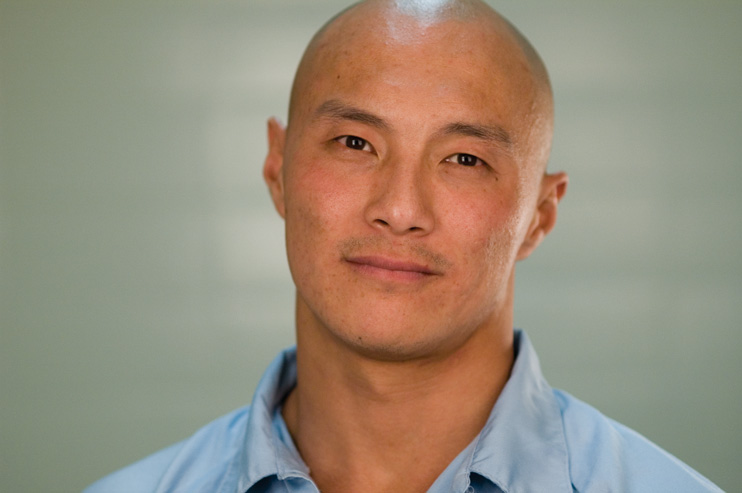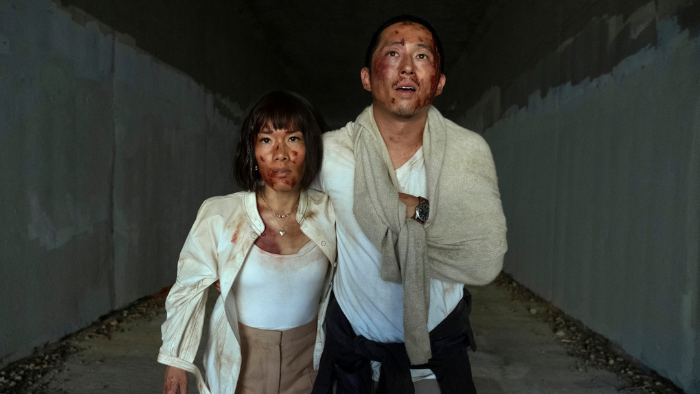Photos courtesy of Iris Shim/Grayscale Films
Filmmaker Iris Shim and editor Joseph Lee hope to generate additional funding to finish “The House of Suh.”
The camera focuses on a color photo of an immigrant Korean man with his baby son on his lap; both are dressed in hanboks. A young man’s voice is heard: “I always relished my idea of being the son. I was always so involved with my family’s life, that I lived my life for them.” Then, a black-and-white family photo appears, and the camera zooms in on the serious-faced girl with braids. “But it was different for Catherine because she came to America in about her teen years,” the voice says. “She wanted to rebel. She wanted to be the ‘all-American girl,’ and my father didn’t like that.”
The scene is taken from a new documentary that explores the cultural and generational rifts in an immigrant Korean American family. Tragically, this real-life tale also involves murder, manipulation and betrayal.
For the last two years, Illinois-based filmmaker Iris Shim has been working on “House of Suh,” a documentary exploring the circumstances that led siblings Catherine and Andrew Suh to plan and execute, respectively, the 1993 murder of Catherine’s boyfriend, Robert O’Dubaine. According to authorities, Catherine had convinced her younger brother, then 19, that O’Dubaine was the one who had brutally stabbed their mother to death in 1987 to get his hands on insurance money and that it was Andrew’s duty to avenge it. Police never arrested anyone in connection with the mother’s killing, though they suspected Catherine, who with O’Dubaine used the inheritance money to buy a nightclub and live extravagantly. O’Dubaine served as Catherine’s alibi.
The unfinished “House of Suh” focuses particularly on Andrew, the good son, the congenial boy, the well-liked high school student body president. He was enrolled at Providence College in Rhode Island on a full scholarship when he admitted to lying in wait in the garage of the Bucktown, Ill., home O’Dubaine shared with Catherine and planting two bullets in his victim’s head. He is currently serving an 80-year sentence at the Pontiac Correctional Facility in Illinois. His sister is serving a life term without parole 30 miles away. Andrew is eligible for parole in 2035.
Andrew had one “fatal flaw,” says the 25-year-old Shim. “He’s got this fatal flaw of loyalty, which is why he is where he is.”
Her documentary is not about how this “Korean kid killed this guy,” she explains, “but about how someone could get to the point to kill another human being.”
Shim has a unique lense into Andrew’s life: she considers the 33-year-old inmate a close friend of six years.
After his conviction in 1995, Andrew wrote four- and five-page letters to Korean newspapers and churches, warning other young Korean Americans against the mistakes he had made. The letters won Andrew a network of supporters at a Chicago church he once attended, the same church where Shim served as the president of her youth group. She was a senior in high school when a church friend was so moved by one of Andrew’s letters that she started writing to him. Shim, then 18, decided to accompany this friend on a prison visit.
Andrew and Shim became instant friends after their first meeting in 2001. She was taken by the fact that he was so “eloquent and charming,” even funny, though in such a depressing environment. Since then, Andrew has acted as an older brother figure, giving her advice on everything from college (even though he never graduated) to cars, and he even prepared for her a detailed diagram for opening a sushirestaurant, a venture that Shim had briefly considered with a friend a few years ago. He stood up for her when Shim’s mother initially did not support her decision to move to California to pursue filmmaking.
Shim, who immigrated to the U.S. from Korea with her parents at 3 months old, studied psychology at the University of Illinois at Chicago, but soon after graduating in 2004, she hopped on a plane to Los Angeles with no film training and no job prospects. After taking a film course, she served as a production assistant on a few features, including Tobe Hooper’s “Mortuary.” In December 2005, she moved back home to Glenview, Ill. Andrew had asked her if she knew anyone who might be interested in documenting his story. She volunteered.
Some might accuse Shim of a conflict of interest in telling the story of a convicted murderer in the eyes of many, but a big brother to her. In her defense, Shim points out that people do not watch documentaries necessarily to get an unbiased story. At the same time, she adds that this film is not an advocacy film for Andrew, whose pro-bono attorneys are currently seeking a reduction to his 80-year sentence, which is double the usual sentence for murder in Illinois.
Shim also has crew members, including co-producer Gerry Kim and editor Joseph Lee, who are not shy about voicing their concerns if they feel the film is favoring one point of view too heavily. The focus of the documentary is “not to justify guilt or innocence,” explains Shim. “[Andrew] admits guilt. A lot of things happened in [Andrew and Catherine’s] upbringing to get them to the point where she would plan the murder and for him to execute it. I always found the story fascinating.”
***
Fourteen years ago, the media had a field day with this twisted murder case that had “made-for-TV movie” written all over it. Catherine was dubbed the “Black Widow” by some media outlets for planning the murder of her boyfriend so she could collect on his $250,000 life insurance policy. Catherine was supposed to be tried with her brother for the O’Dubaine murder, but she abandoned him two days before their scheduled court date. She was convicted of conspiracy to commit murder in absentia.
A few months after an appearance on “America’s Most Wanted,” Catherine was arrested in Hawaii, where she had been living under an alias with a surfer boyfriend in Honolulu. The case became the basis for a television movie called “Bad to the Bone” a year later.
The media seemed equally fascinated by Andrew, who appeared to stay loyal to his sister, refusing to testify against her to help his own case, even after she abandoned him.
Shim wanted to make this documentary in part to humanize the people behind the sensational headlines and to add context to this awful crime.
The young filmmaker observes that the Suh siblings reacted so differently to the pressures they faced as Korean immigrants: Andrew embraced his Korean identity and his role as the loyal son of the family, while Catherine, who wanted to be more “American” and dated interracially, defied her parents’ wishes again and again. That led to a great deal of tension and some explosive fights between Catherine and her father. According to Shim, court transcripts of the trial testimony from one of Catherine’s ex-boyfriends reveal that her father would get so upset at his rebellious daughter that he would beat her while her mother looked on.
A major turning point for the worse occurred when Andrew and Catherine’s father succumbed to cancer in 1985. Two years later, the mother was killed — stabbed 37 times — at her dry cleaning business.
Shim believes, had the influential father — the disciplinarian of the rebellious daughter and figure of adoration for the docile son — not passed away when he did, the siblings would not be in prison now.
“One thing I talked about with my team is how literary the story is,” says Shim. “People say there is no such thing as an original story. It’s almost like in Greek times with gods, you really have no control over your story. … If the father had not died, this whole thing would not have happened.”
In one clip from the documentary, a tearful Andrew, who kept vigil at his father’s hospital bedside, reveals that his dad’s dying wish was for the then-11-year-old to take care of his mother. Andrew, urged repeatedly by his sister to “do it for mom,” believed he was doing that when he killed O’Dubaine eight years later. “I was under the impression that I was doing the right thing, you know?” says the handsome and articulate Andrew, with a hint of naiveté still in his 33-year-old voice.
Before the mother’s death, Andrew hated his sister for being the troublemaker of the family, but after both his parents were gone, Catherine was all the 13-year-old had. “People don’t understand Catherine was like his mom, so she had this strange power over him,” explains Shim.
Catherine’s own voice will likely not be featured in the documentary. An inmate at Dwight Correctional Facility, she has not responded to requests for interviews. Prison guards told Shim that Catherine has not had a visitor since 2001, and she has cut off ties with Andrew. Shim still wants Catherine to be represented as a “real person,” not just a one-dimensional heartless killer, and the filmmaker will rely on interviews with people who knew her to help shed light on this troubled figure.
***
Fourteen interviews and about $13,000 into this filmmaking process, “House of Suh” is still about 10 interviews and thousands of dollars shy of reaching feature length. So far Shim has relied on fundraising parties and donations hustled by her now supportive, church-going mother to pay for equipment and other filmmaking expenses. The unpaid film crew of five is hoping to generate additional funding from film organizations and grants.
In the meantime, Shim keeps a day job as a part-time administrative assistant at the Korean Chamber of Commerce in Chicago. She hopes to wrap up filming by the end of the year.
“House of Suh” is Shim’s first stab at directing, producing and even working on a documentary. She was pursuing training in narrative feature filmmaking when the opportunity to make this documentary arose. Because of that background, she originally attempted to write a script based on the Suh family’s story, but discovered that, in this case, truth proved more unbelievable than fiction.
Filmmaking, regardless of genre, is all about telling a story, Shim concluded. Although the sordid details of this case made for juicy tabloid material when it first came to light 14 years ago, this, at its core, is a family story, the 25-year-old says. It is one of countless stories that comprise the Korean American experience, the Asian American experience, and its unique details illustrate just how different each story can be.
“[It doesn’t] fit into this mold,” says Shim. “This is not the Asian American experience.
“We need [to tell] more stories,” she adds. “Each story has its own merit.”




